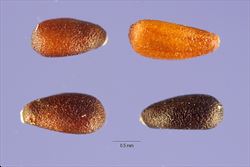Click on images to enlarge

habit prior to flowering (Photo: Sheldon Navie)

habit in flower (Photo: Trevor James)

lower leaves (Photo: Sheldon Navie)

stem, upper leaves and flower clusters (Photo: Trevor James)

close-up of flowers (Photo: Trevor James)

close-up of leaf undersides and immature fruit (Photo: Trevor James)

close-up of seeds (Photo: Jose Hernandez at USDA PLANTS Database)
Scientific Name
Melissa officinalis L.
Synonyms
Melissa officinalis L. subsp. officinalis
Family
Labiatae (South Australia)Lamiaceae (Queensland, New South Wales, the ACT, Victoria, Tasmania, Western Australia and the Northern Territory)
Common Names
balm, balm mint, bee balm, bee herb, blue balm, citronella, common balm, dropsy plant, garden balm, gentle balm, lemon balm, melissa, melissa balm, sweet balm, sweet-balm
Origin
Native to north-western Africa (i.e. Morocco and Tunisia), the Madeira Islands, the Canary Islands, southern Europe (i.e. France, Portugal, Spain, Albania, Bulgaria, Greece, Italy, Romania, Yugoslavia, Belarus, Ukraine and western Russia) and western Asia and northern Pakistan.
Naturalised Distribution
Naturalised in some parts of south-eastern Australia (i.e. in parts of central and southern New South Wales, southern Victoria, Tasmania and south-eastern South Australia).
Notes
Common balm (Melissa officinalis) is regarded as an environmental weed in Victoria, and it is thought to pose a serious threat to one or more vegetation formations in this state. This introduced species, which is grown as a garden herb, has become naturalised in damp habitats and invades creek banks, watercourses and drainage lines. It is listed as an environmental weed in the Goulburn Broken Catchment and has been recorded in Morwell National Park.
Common balm (Melissa officinalis) also grows in moist areas, usually along creeks, in South Australia and New South Wales. It has also been recorded from conservation areas in south-eastern South Australia (i.e. Horsnell Gully Conservation Park and Belair National Park).

